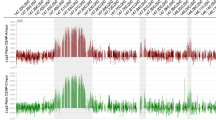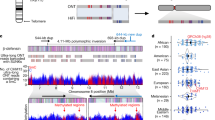Abstract
It has been hypothesized that human clinical neocentromeres and evolutionary novel centromeres (ENC) represent two faces of the same phenomenon. However, there are only two reports of loci harboring both a novel centromere and a clinical neocentromere. We suggest that only the tip of the iceberg has been scratched because most neocentromerization events have a very low chance of being observed. In support of this view, we report here on a neocentromere at 9q33.1 that emerged in a ring chromosome of about 12 Mb. The ring was produced by a balanced rearrangement that was fortuitously discovered because of its malsegregation in the propositus. Chromatin-immunoprecipitation-on-chip experiments using anti-centromere protein (CENP)-A and anti-CENP-C antibodies strongly indicated that a novel centromeric domain was present in the ring, in a chromosomal domain where an ENC emerged in the ancestor to Old World monkeys.



Similar content being viewed by others
References
Aleixandre C, Miller DA, Mitchell AR, Warburton DA, Gersen SL, Disteche C, Miller OJ (1987) p82H identifies sequences at every human centromere. Hum Genet 77:46–50
Alonso A, Fritz B, Hasson D, Abrusan G, Cheung F, Yoda K, Radlwimmer B, Ladurner AG, Warburton PE (2007) Co-localization of CENP-C and CENP-H to discontinuous domains of CENP-A chromatin at human neocentromeres. Genome Biol 8:R148
Amor DJ, Choo KH (2002) Neocentromeres: role in human disease, evolution, and centromere study. Am J Hum Genet 71:695–714
Amor DJ, Bentley K, Ryan J, Perry J, Wong L, Slater H, Choo KH (2004) Human centromere repositioning “in progress". Proc Natl Acad Sci USA 101:6542–6547
Bieda M, Xu X, Singer MA, Green R, Farnham PJ (2006) Unbiased location analysis of E2F1-binding sites suggests a widespread role for E2F1 in the human genome. Genome Res 16:595–605
Carbone L, Nergadze SG, Magnani E, Misceo D, Francesca Cardone M, Roberto R, Bertoni L, Attolini C, Francesca Piras M, de Jong P, Raudsepp T, Chowdhary BP, Guerin G, Archidiacono N, Rocchi M, Giulotto E (2006) Evolutionary movement of centromeres in horse, donkey, and zebra. Genomics 87:777–782
Cardone MF, Alonso A, Pazienza M, Ventura M, Montemurro G, Carbone L, de Jong PJ, Stanyon R, D'Addabbo P, Archidiacono N, She X, Eichler EE, Warburton PE, Rocchi M (2006) Independent centromere formation in a capricious, gene-free domain of chromosome 13q21 in Old World monkeys and pigs. Genome Biol 7:R91
Cardone MF, Lomiento M, Teti MG, Misceo D, Roberto R, Capozzi O, D'Addabbo P, Ventura M, Rocchi M, Archidiacono N (2007) Evolutionary history of chromosome 11 featuring four distinct centromere repositioning events in Catarrhini. Genomics 90:35–43
Chueh AC, Wong LH, Wong N, Choo KH (2005) Variable and hierarchical size distribution of L1-retroelement-enriched CENP-A clusters within a functional human neocentromere. Hum Mol Genet 14:85–93
De Gregori M, Ciccone R, Magini P, Pramparo T, Gimelli S, Messa J, Novara F, Vetro A, Rossi E, Maraschio P, Bonaglia MC, Anichini C, Ferrero GB, Silengo M, Fazzi E, Zatterale A, Fischetto R, Previdere C, Belli S, Turci A, Calabrese G, Bernardi F, Meneghelli E, Riegel M, Rocchi M, Guerneri S, Lalatta F, Zelante L, Romano C, Fichera M, Mattina T, Arrigo G, Zollino M, Giglio S, Lonardo F, Bonfante A, Ferlini A, Cifuentes F, Van Esch H, Backx L, Schinzel A, Vermeesch JR, Zuffardi O (2007) Cryptic deletions are a common finding in “balanced” reciprocal and complex chromosome rearrangements: a study of 59 cases. J Med Genet 44:750–762
du Sart D, Cancilla MR, Earle E, Mao J, Saffery R, Tainton KM, Kalitsis P, Martin J, Barry AE, Choo KHA (1997) A functional neo centromere formed through activation of a latent human centromere and consisting of non-alpha-satellite DNA. Nat Genet 16:144–153
Eder V, Ventura M, Ianigro M, Teti M, Rocchi M, Archidiacono N (2003) Chromosome 6 phylogeny in primates and centromere repositioning. Mol Biol Evol 20:1506–1512
Lichter P, Tang Chang C-J, Call K, Hermanson G, Evans GA, Housman D, Ward DC (1990) High resolution mapping of human chromosomes 11 by in situ hybridization with cosmid clones. Science 247:64–69
Montefalcone G, Tempesta S, Rocchi M, Archidiacono N (1999) Centromere repositioning. Genome Res 9:1184–1188
Stanyon R, Rocchi R, Capozzi O, Roberto R, Misceo D, Ventura M, Cardone M, Bigoni F, Archidiacono N (2008) Primate chromosome evolution: ancestral karyotypes, marker order and neocentromeres. Chromosome Res in press
Therman E, Susman M (1993) Human chromosomes: structure, behavior and effects.. Springer, New York, NY, USA
Ventura M, Archidiacono N, Rocchi M (2001) Centromere emergence in evolution. Genome Res 11:595–599
Ventura M, Mudge JM, Palumbo V, Burn S, Blennow E, Pierluigi M, Giorda R, Zuffardi O, Archidiacono N, Jackson MS, Rocchi M (2003) Neocentromeres in 15q24–26 map to duplicons which flanked an ancestral centromere in 15q25. Genome Res 13:2059–2068
Ventura M, Weigl S, Carbone L, Cardone MF, Misceo D, Teti M, D'Addabbo P, Wandall A, Björck E, de Jong P, She X, Eichler EE, Archidiacono N, Rocchi M (2004) Recurrent sites for new centromere seeding. Genome Res 14:1696–1703
Ventura M, Antonacci F, Cardone MF, Stanyon R, D'Addabbo P, Cellamare A, Sprague LJ, Eichler EE, Archidiacono N, Rocchi M (2007) Evolutionary formation of new centromeres in macaque. Science 316:243–246
Warburton PE (2004) Chromosomal dynamics of human neocentromere formation. Chromosome Res 12:617–626
Wells J, Farnham PJ (2002) Characterizing transcription factor binding sites using formaldehyde crosslinking and immunoprecipitation. Methods 26:48–56
Acknowledgements
This work was supported by PRIN 2006, PRIN 2005 (to O.Z.), FIRB 2004, and Fondazione Mariani and Fondazione Cassa di Risparmio delle Provincie Lombarde. We thank the family for cooperation. We would like to thank M. Zoli for technical advice and S. Trazzi for anti-CENP-A and anti-CENP-C sera. S. P. was supported by a fellowship from European Union—Programma Regionale per la Ricerca Industriale and L’Innovazione e Il Trasferimento Tecnologico of the Emilia Romagna Region.
Author information
Authors and Affiliations
Corresponding author
Additional information
Communicated by H. Masumoto
Rights and permissions
About this article
Cite this article
Capozzi, O., Purgato, S., Verdun di Cantogno, L. et al. Evolutionary and clinical neocentromeres: two faces of the same coin?. Chromosoma 117, 339–344 (2008). https://doi.org/10.1007/s00412-008-0150-z
Received:
Revised:
Accepted:
Published:
Issue Date:
DOI: https://doi.org/10.1007/s00412-008-0150-z




